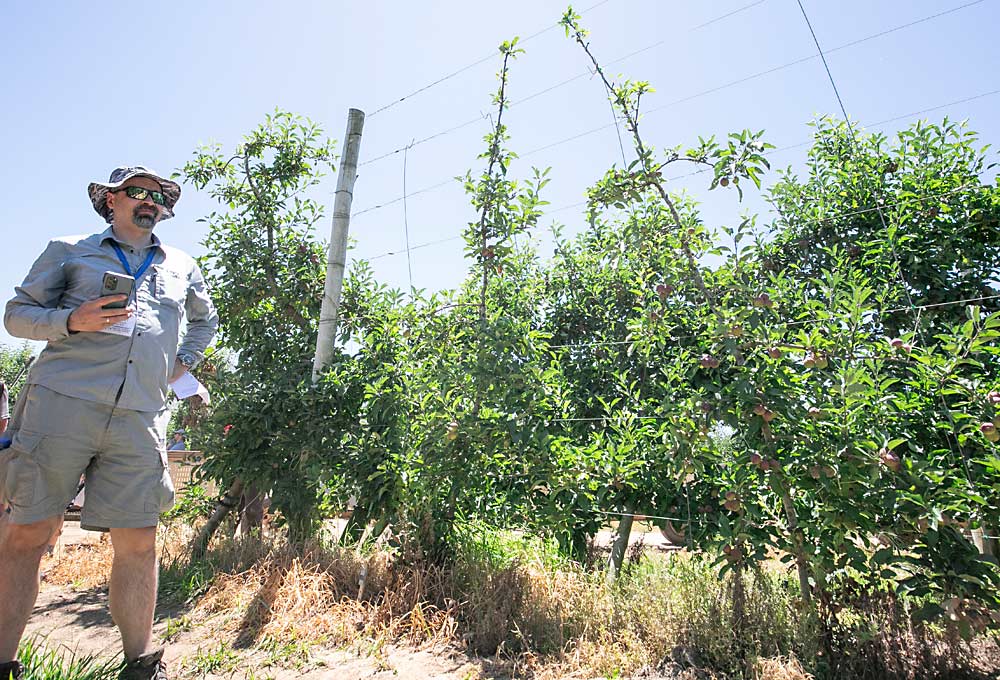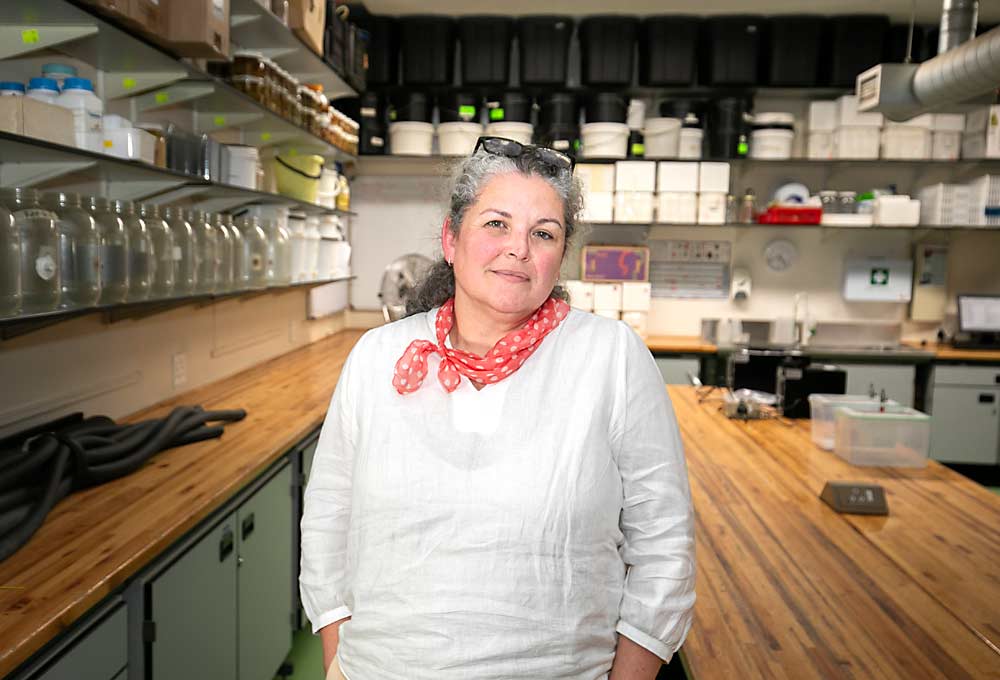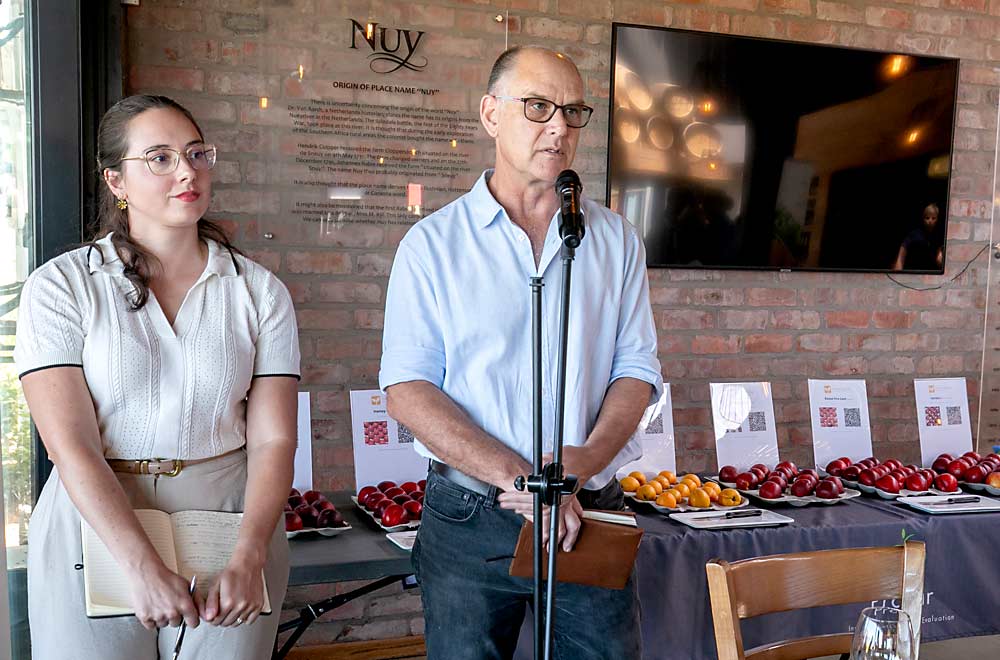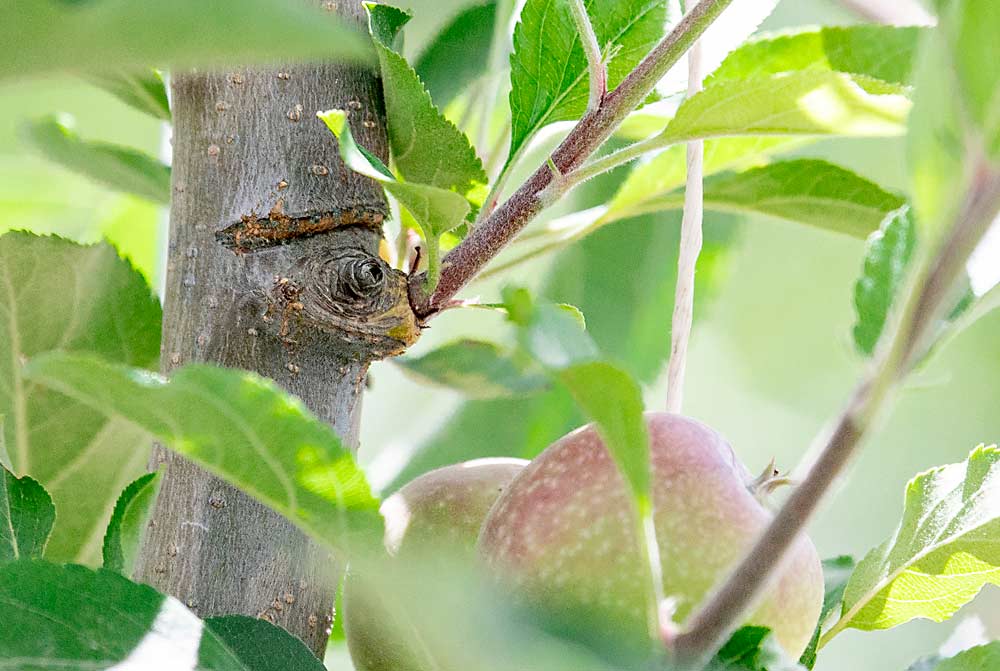—story by Kate Prengaman
—photos by TJ Mullinax

Apple trees usually want to grow up.
Horticultural systems were engineered around the trees’ innate apical dominance, but without winter chill to trigger the system reboot that takes place during dormancy, they develop more basal dominance.
“The buds at the top don’t wake up like they should,” said Esmé Louw, chair of the preharvest horticultural science department at Stellenbosch University in South Africa. “They become Christmas trees down here.”
The result: Growers in areas with warm winters are “forever fighting the tree” to fill space, she said. Growers invest in painstaking notching, scoring and plant growth regulators to encourage growth in the top part of the tree.
“Because of our unique climate and lack of winter chill, which is not going to get better, we use rest-breaking agents as standard practice,” Louw said.

Even with tools to mitigate chill challenges, some cultivars are better suited to low-chill climates than others. But “suited for the climate” is a complex concept — maybe a cultivar responds well to rest-breaking agents but is highly susceptible to sunburn; maybe a cultivar grows and yields well in hot climes, but the resulting fruit doesn’t store well.
To tease out the many facets of a cultivar’s climate adaptability, the South African pome and stone fruit industry invested in a series of research trials, planting 10 cultivars each of apples, plums and cherries in different climate zones in 2019. Three years later, project leaders Louw and Iwan Labuschagne, the founder of cultivar evaluation company Provar, added a pear trial as well. All the trials are funded by Hortgro, the industry’s grower association.
The project’s primary goal: creating an adaptability index that encompasses phenology, tree architecture, yield and fruit quality, Labuschagne said.
The 10 genotypes were specifically chosen to represent a range of low chill to high chill, Labuschagne said. “They were captured to represent all the genetic variation we can expect in terms of (climate) adaptability,” he said. “So, we can (make) this baseline of cultivar responses to the environment.”

That index will support Provar’s independant evaluation process to help the South African industry find well-suited cultivars sooner. Investing in evaluation, rather than local breeding, helps the industry take advantage of the global proliferation of new cultivars, said Labuschagne, who started his career as a breeder. He bred several low-chill apple varieties, including two in the trial planting, Afri-Blush and Afri-Glow.
Provar serves as a data management center for cultivar owners, collecting data about tree performance in different South African climates, and to answer wider industry questions about how the environment shapes the cultivars’ gene expression.
“If we can develop a library of indexes for how different cultivars do in different environments, then we can start zooming in (on specific questions),” he said — questions such as those about dormancy, tree architecture or fruit quality. Researchers can mine existing data to answer future questions, too.
Student interns and staff scientists on the Provar team are now crunching the data to build those adaptability indexes, but the trial plantings have found a second purpose as a research platform for many questions at the intersection of cultivar genetics and environmental conditions.
Now renamed the Pro-Hort Ecophysiology Platform, project leaders are inviting other scientists to bring their research questions to the trial plantings, since the replicates of the same 10 cultivars, planted at sites with a wide range of winter chill, summer heat and other climate stresses, provide an in-field laboratory.
“It’s so rare to find a replicated experiment with multiple cultivars in multiple environments that is already in production,” said Lee Kalcsits, an environmental physiologist at Washington State University who spent a sabbatical in 2024 in South Africa studying sunburn.
Kalcsits said his research explores the cultivar differences in sunburn in the different environments, which is related to what’s going on in the fruit itself, tree growth habit, vegetative vigor and other traits.

“There’s a wide range in how the trees grow; it’s not just differences in chill. What comes out of this is we’ll identify factors that go into sunburn physiology and the tree/environment interactions,” Kalcsits said, adding that the findings should apply to growing regions across the globe.
“It was a great opportunity, and they have identified a great collaborative approach at Stellenbosch,” he said.
WSU tree fruit physiologist Stefano Musacchi heads to South Africa this February, where he will use the platform to investigate blind wood development.
For Louw, the platform supports more research into the physiology underlying chill, which is far more complex than its name suggests.
She explains it this way: A tree is really a bunch of different meristems that grew differently each season, based on their exposure to specific plant hormones. Dormancy acts as the reset button that synchronizes everything in time, so that all the meristems wake up together. Without sufficient winter chill during dormancy, the variable growth rates and exposure from the previous season can carry over into the new year, creating a variable mess rather than coordinated growth.
“It’s like comparing a horse race where they are all lined up and ready versus starting a race where some horses are at the starting line and some are still in the stalls or wandering off somewhere,” she said.
Existing chill models fail to capture that variability and aren’t serving the South African industry well. Seeing the variance between how the same cultivars perform in different climates — with and without rest-breaking agents — shows just how much the climate influences cultivar phenotype.
“We’ve planted them where they don’t belong so we can see how far we can take this,” Louw said. “There are a lot of genes at work in dormancy. It’s very elusive.” •






Leave A Comment